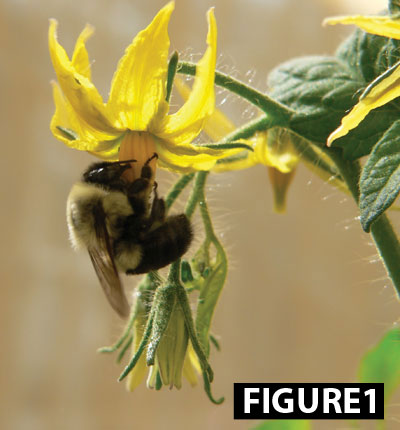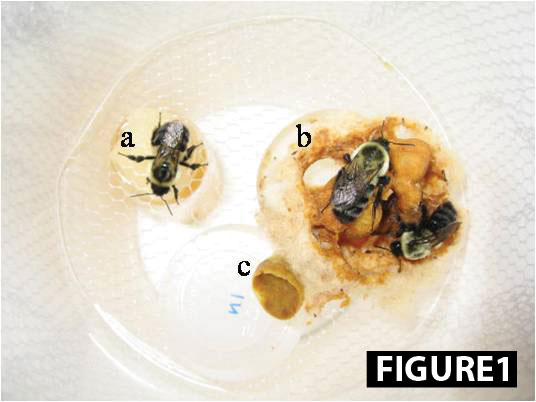
Features
Biocontrols
Inputs
The star pollinators
January 11, 2010 By Angela Gradish Cynthia Scott-Dupree Les Shipp Ron Harris Gillian Ferguson
Bumblebees (Bombus impatiens Cresson) (Figure 1) have become increasingly common in Canadian vegetable greenhouses as most growers rely on them to provide supplemental pollination. Tomatoes and sweet peppers are self-pollinating, but supplemental pollination results in larger, more attractive fruit. When a bumblebee colony is placed in the greenhouse, female worker bees begin to collect pollen to feed to the developing larvae. More worker bees then emerge, resulting in further pollen collection. Therefore, successful pollination is partially dependent on the bees’ ability to produce large numbers of workers to forage.
Bumblebees (Bombus impatiens Cresson) (Figure 1) have become
increasingly common in Canadian vegetable greenhouses as most growers
rely on them to provide supplemental pollination. Tomatoes and sweet
peppers are self-pollinating, but supplemental pollination results in
larger, more attractive fruit. When a bumblebee colony is placed in the
greenhouse, female worker bees begin to collect pollen to feed to the
developing larvae. More worker bees then emerge, resulting in further
pollen collection. Therefore, successful pollination is partially
dependent on the bees’ ability to produce large numbers of workers to
forage.
In essence, bumblebees can be considered the stars of the greenhouse pollination world.
Compared with manual pollination, bumblebee pollination is less labour
intensive and results in higher yields. Bumblebees also are superior to
honey bees for a variety of reasons. Their hairy bodies allow them to
collect and carry more pollen, they are active at lower temperatures
and light intensities, and they are capable of “buzz” pollination
(vibrating the flower to release pollen), which is required for
tomatoes.
 |
|
| A Bombus impatiens worker |
|
 |
|
| A micro-colony containing: a) a feeder filled with honey/water solution; b) a wax-coated pollen ball; and c) the nest with larvae. | |
 |
|
| FIGURE 3. Average corrected per cent mortality (± SE) of bumblebee workers 72 hours following exposure to technical grade imidacloprid, abamectin, metaflumizone, or chlorantraniliprole using a Potter spray tower. Insecticides were applied at 0.001, 0.01, or 0.1% w/v. Columns with the same letter are not significantly different. |
|
 |
|
| FIGURE 4. Average worker lifespan (days) and pollen consumption (g) (± SE) of bumblebee micro-colony workers. Queen-less micro-colonies received pollen contaminated with formulated imidacloprid, abamectin, metaflumizone, chlorantraniliprole, myclobutanil, potassium bicarbonate, or cyprodinil+fludioxonil. Control colonies were provided with pollen mixed with honey and water only. Columns with the same letter are not significantly different. |
|
 |
|
| FIGURE 5. Average number of days to first egg-laying and number of larvae ejected (± SE) by bumblebee micro-colony workers. Queen-less micro-colonies received pollen contaminated with formulated imidacloprid, abamectin, metaflumizone, chlorantraniliprole, myclobutanil, potassium bicarbonate, or cyprodinil+fludioxonil. Control colonies were provided with pollen mixed with honey and water only. Columns with the same letter are not significantly different.
|
THE PROBLEM IS SOME PESTICIDES MAY BE HARMFUL TO BUMBLEBEES
In addition to pollination, effective pest management is crucial for
maintaining high yields of marketable fruit. Insecticides are
occasionally used for control of insect pests and fungicides are
routinely applied for powdery mildew. The problem is that some
pesticides may be harmful to bumblebees. While bumblebees are foraging,
they may come into contact with pesticides as a foliar spray, residues
on plants, or by consuming contaminated pollen. This exposure may
result directly in bee mortality or in sub-lethal effects, such as
reduced lifespan, reduced ability to reproduce, or behavioural changes.
Additionally, contaminated pollen may be fed to developing larvae,
which can result in larval mortality or changes in development. In
either case, the result is fewer bees, less pollination, and a
reduction in yield and fruit quality. Therefore, as new pesticides are
developed for greenhouse vegetable use, it’s important to determine
their potential impact on bumblebees.
STUDY EXAMINED SEVERAL INSECTICIDES AND FUNGICIDES REGISTERED FOR USE IN CANADA
To accomplish this, a study was recently conducted at the University of Guelph by Angela Gradish under the supervision of
Drs. Cynthia Scott-Dupree (University of Guelph) and Les Shipp
(Agriculture and Agri-Food Canada), and in collaboration with Dr. Ron
Harris (University of Guelph) and Gillian Ferguson (Ontario Ministry of
Agriculture, Food and Rural Affairs). The study examined the toxicity
of some insecticides and fungicides currently used or in the process of
being registered for use in Canadian greenhouse vegetable production to
bumblebee health and reproduction. The objective of the study was to
identify and use pesticides that are safe to apply in greenhouses in
the presence of bumblebees.
The insecticides tested included imidacloprid (Intercept®, Bayer
CropScience Canada), abamectin (Avid®, Syngenta Crop Protection Canada
Inc.), metaflumizone (Alverde™, BASF Canada), and chlorantraniliprole
(Coragen®, Dupont Canada). Alverde is being registered for lygus bug in
pepper and cucumber beetle in cucumber, while Coragen is registered for
cabbage looper. The fungicides tested included myclobutanil (Nova®, Dow
Agrosciences Canada), potassium bicarbonate (Milstop®, Bioworks Inc.),
and cyprodinil + fludioxonil (Switch®, Syngenta Crop Protection Canada
Inc.).
IN A NORMAL BUMBLEBEE COLONY, ONLY THE QUEEN LAYS EGGS
In the first experiment, adult female worker bumblebees were exposed
to a direct spray of the active ingredient of each pesticide using a
Potter spray tower (a type of specialized spray chamber). Each
pesticide was applied at 0.001, 0.01, and 0.1 per cent w/v. The impact
on adult mortality was then assessed. In the second experiment,
possible sub-lethal effects of each formulated pesticide were
determined. In a normal bumblebee colony, only the queen lays eggs.
However, if a group of workers is isolated from the queen, one dominant
worker will begin laying eggs, while the other workers provide food for
the developing larvae. For this study, bumblebee “micro-colonies” were
created by isolating groups of three workers in cages (Figure 2). Each
micro-colony was then provided with pollen treated with an insecticide
or fungicide at label rate for 30 days, on which they reared their
larvae. Time to first egg laid, larval ejection rates, amount of pollen
consumed, and adult worker lifespan were monitored for 60 days.
When directly applied to adult bumblebees, imidacloprid and abamectin
both caused high mortality (Figure 3). Metaflumizone also caused
mortality at high concentrations (Figure 3). However,
chlorantraniliprole did not cause any mortality (Figure 3). Similarly,
all fungicides tested were harmless as a direct spray, causing less
than five per cent mortality. In the sub-lethal study, Intercept and
Avid increased time to first eggs laid, reduced worker bee lifespan,
and reduced pollen consumption (Figures 3 and 4). Metaflumizone and
chlorantraniliprole had no effect on egg-laying, larval ejection,
worker bee lifespan, or pollen consumption (Figures 4 and 5). Finally,
none of the fungicides tested caused sub-lethal effects (Figures 4 and
5).
CHOOSING REDUCED RISK PESTICIDES WILL HELP ENSURE BUMBLEBEES PROVIDE EFFECTIVE POLLINATION
These results suggest that imidacloprid and abamectin have the
potential to severely impact bumblebee health and reproduction and
therefore greenhouse pollination. If Intercept or Avid must be used,
steps can be taken to protect bumblebees. Exit holes on the colonies
can be closed in the evening until all foraging workers have returned. The colonies should then be completely closed
prior to insecticide application and not re-opened until the
recommended re-entry period. Metaflumizone and chlorantraniliprole
appear to be safer alternatives for greenhouse insect pest management.
The fungicides myclobutanil, potassium bicarbonate, and cyprodinil +
fludioxonil appear to have no impact on bumblebees and can be safely
used in greenhouses where bumblebees are released. Choosing to use
these reduced risk pesticides will help ensure that the bumblebees
remain healthy and able to provide effective pollination.
Funding for this research was provided by the Pest Management Centre of
AAFC and a CORD IV grant provided to the Ontario Greenhouse Vegetable
Growers by the Agricultural Adaptation Council.
Print this page